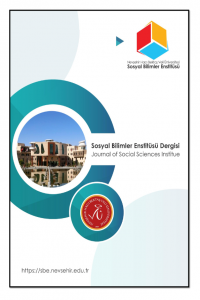Abstract
Birçok açıdan kendine özgü özellikler gösteren Çekya, Orta Avrupa’nın özellikle Kadife Devrim sonrasında dikkat çeken ülkerinden birisidir. Nispeten küçük yüzölçümüne rağmen bağımsızlığını kazandığı günden günümüze kadar birçok tarihsel olaya şahit olan ülkede bu değişimin izlerinin en güzel göstergelerinden birisi de nüfustur. Bu çalışmada, genel olarak, geçmişten günümüze Çek Cumhuriyeti’nin nüfus değişimi ve daha özelde de günümüzde Çekya’nın nüfus özellikleri ve nüfusun mekansal dağılımı ele alınmıştır. Açıkçası Çekya’daki nüfus değişimi tarihsel olaylarla doğrudan bağıntılıdır. Birinci Dünya Savaşı sonrasında 1918 yılında bağımsızlığını kazanan Çekoslavakya’nın İkinci Dünya Savaşı sonrasında topraklarının bazı bölümlerini kaybetmesi ve savaş esnasında Nazi Almanları ile işbirliği yapan Südetya Almanları’nın zorunlu göçe tabi tutulması Çekya’daki nüfus değişimini etkileyen en önemli olaylardandır. Soğuk Savaş döneminde ülkeye göç eden Vietnamlılar günümüzde Çek nüfus coğrafyasının bir diğer önemli niteliklerinden birisidir. Uzun yıllar kader birliği yapmış Çekler ve Slovaklar Kafide Devrim ile Kadife Boşanma denilen olayla ayrılıp yollarına ayrı devam etmişlerdir. Komünist rejim sonrasından günümüze kadar geçen otuz sene içinde serbest piyasa ekonomisine geçiş ve Avrupa Birliği’ne giriş ülkeyi etkileyen en önemli olaylardandır ve bu bağlamda özellikle küreselleşme denen olgunun izlerini nüfus üzerinde de görmek mümkündür. Bohemya, Moravya ve Silezya şeklinde üç tarihi bölgeye ayrılan Çekya idari olarak on dört bölgeye ayrılmıştır. Her tarihi bölgenin merkezi şehri aynı zamanda ülkenin en kalabalık şehiridir. Buna göre Bohemya Bölgesi’nin merkezi şehri ve aynı zamanda ülkenin de başkenti olan Prag ülkenin nüfusu en fazla olan şehriyken, peşinden sırasıyla Moravya’nın merkezi şehri Brno ülkenin ikinci büyük şehri, Silezya’nın merkezi şehri olan Ostrava ülkenin üçüncü büyük şehridir. Aynen şehirlerin sıralanışında olduğu gibi bu bölgelerin yüz ölçümü, nüfus miktarı ve gelişmişlik düzeyleri arasında paralellik vardır.
Keywords
References
- Alamgir, A. K. (2013). Race is elsewhere: state-socialist ideology and the racialisation of Vietnamese workers in Czechoslovakia. Race & Class, 54(4), 67-85.
- Beeson, T. (1982). Discretion and valour: religious conditions in Russia and Eastern Europe (p. 229). Philadelphia: Fortress Press.
- Cravens, C. S. (2006). Culture and customs of the Czech Republic and Slovakia. Greenwood Publishing Group.
- Creighton, H. (2014). Europe’s ageing demography. International Longevity Centre: London, UK
- Cviklova, L. (2015). Direct and indirect racial discrimination of Roma people in Bulgaria, the Czech Republic and the Russian Federation. Ethnic and Racial Studies, 38(12), 2140-2155.
- Český statistický úřad, https://www.czso.cz/csu/czso/home,12.01.2019.
- Dufek, J., & Minařík, B. (2009). Age of population and the development of population ageing in the regions of the Czech Republic. Agricultural Economics, 55(6), 259-270 Hamplová, D., & Nešpor, Z. R. (2009). Invisible religion in a “non-believing” country: The case of the Czech Republic. Social Compass, 56(4), 581-597.
- Hüwelmeier, G. (2015). Mobile Entrepreneurs: Transnational Vietnamese in the Czech Republic. In Rethinking Ethnography in Central Europe (pp. 59-73). Palgrave Macmillan, New York.
- Liu, J. (2018). A Comparative Study of The Effect of Bologna Process on the Italian Higher Education and Czech Higher Education. Education Reform Journal, 3(1), 24-31.
- Müllerová, P. (1998). Vietnamese diaspora in the Czech Republic. Archív orientální, 66(2), 121-126.
- Nožina, M. (2010). Crime networks in Vietnamese diasporas. The Czech Republic case. Crime, law and social change, 53(3), 229-258.
- Schrör, H. (2008). Business demography in Europe: employers and job creation. Statistics in Focus, 100.
- Spousta, J. (2002). Changes in religious values in the Czech Republic. Sociologický časopis/Czech Sociological Review, 38(3), 345-364.
- Svatošová, L. (2010). Comparison of demographic development in the CR and the EU countries. Agricultural Economics, 56(4), 176-182
- Svatošová, L. (2013). The development of regional disparities in Czech Republic over the 2005–2010 years. Acta Universitatis Agriculturae et Silviculturae Mendelianae Brunensis, 60(7), 337-344.
- Thirring, Lajos (1942). "Vármegyéink területe, népességfejlődése, népsűrűsége és közigazgatási felosztása" [Territory, population increase and density, and administrative divisions of our counties]. Magyar Statisztikai Szemle (in Hungarian). Budapest: Magyar Királyi Központi Statisztikai Hivatal. 20 (4): 179.
- Toma, P. A., & Reban, M. J. Church-State Schism in Czechoslovakia. Bociurkiw and Strong, Religion and Atheism, 273-91.
- Vermeersch, P. (2003). Ethnic minority identity and movement politics: The case of the Roma in the Czech Republic and Slovakia. Ethnic & Racial Studies, 26(5), 879-901.
- Weibl, G. (2015). Cosmopolitan identity and personal growth as an outcome of international student mobility at selected New Zealand, British and Czech universities. Journal of international Mobility, (1), 31-44.
Details
| Primary Language | Turkish |
|---|---|
| Journal Section | Articles |
| Authors | |
| Publication Date | June 22, 2020 |
| Published in Issue | Year 2020 Volume: 10 Issue: 1 |

